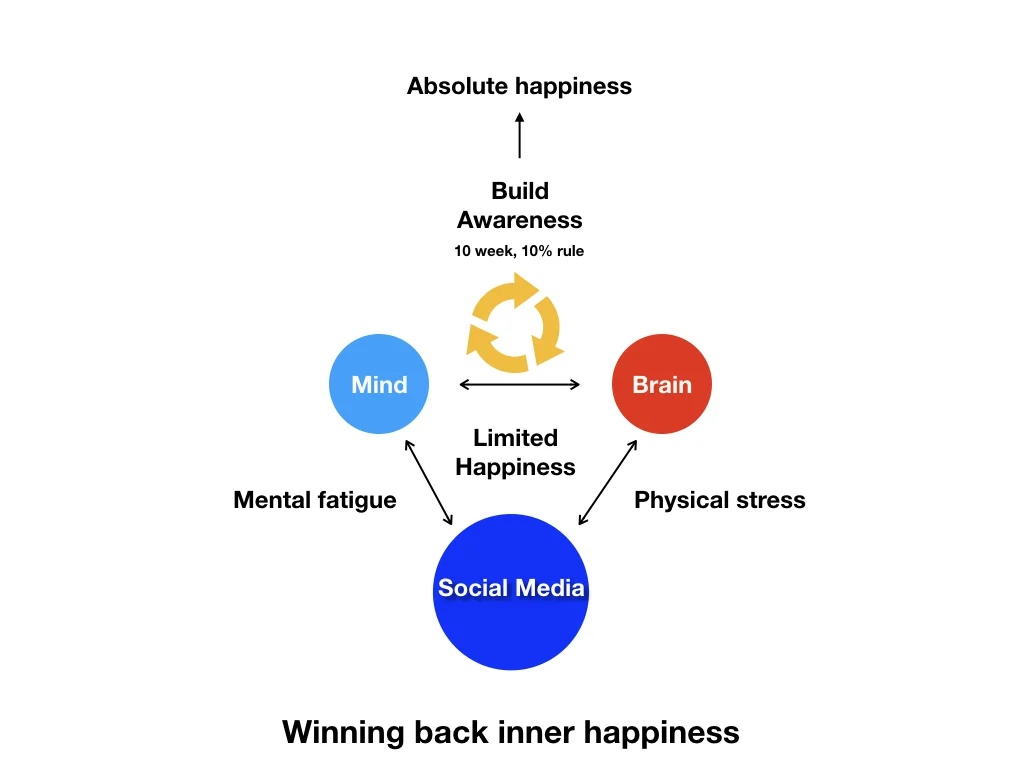Taking the ills out of social media and winning back inner happiness. The 10 week, 10% rule
Networking has shot into prominence lately with the emergence of social media. Networking is as old as the human mind-brain complex. Neural networks in the human brain are complex, with infinite permutations and combinations. Besides controlling and managing the complex machinery of the human body and its trillions of cells, these neural connections interface with the mind in ways which are poorly understood. Similar connections exist between thoughts which create the inner reflections of life. By identifying with some of these inner reflections as happiness and others as misery and sorrow, the unique personal experience of life unfolds. Squeezing lasting happiness from the mind involves controlling complex networks that exist between thoughts and interfacing them with the neural network in the brain. People to people interactions are an extension of the inbuilt networks within the brain and the mind, and their interrelationships. In this fast-paced world, personal one on one interactions has been superseded by connections provided by the internet which is the collective outer “brain” and social media which is the collective contemporary “mind”.
Creating and enjoying our own experiences takes effort, and for those in high pressured jobs and/or those living in densely populated urban areas it also involves significant time away from work as well as monetary cost. Hence the growth of social media which has interconnected people across the globe, from various cultures and backgrounds in ways that were unimaginable just a few decades ago. This crowdsourcing of experiences through social media has created much more variety and the novelty of this new mode of interaction with the world is very appealing to the human mind and it fits right into the mental fabric.
Happiness derived from the mind, however, is transient and it comes and goes. Social media serves to fill in these gaps and provide a more consistent stream of happiness. The addicting nature of social media stems from this. As our fingertips dance on the screen of our smartphones, much of the bandwidth of the neural and thought networks is given up in the pursuit of happiness through an OLED screen of a smartphone. As more people throng the social media space, much to the delight of the originators of the various platforms who profit from our interactions, the window of happiness has come to be defined by the width of our smartphone screens and its processor speed.
One aspect of our happiness correlates with how much the mind is at rest. For most us, unless we are into mind-bending meditational practices, the only aspect of happiness that we know of is external. These external influences, when perceived as beneficial to and pleasant, can help calm the mind. This relative happiness contrasts with the more lasting and fulfilling intrinsic happiness that does not depend on the direction or the flow of the mind, our thoughts, the world around us etc. Intrinsic happiness can be thought of as “static happiness” and extrinsic happiness can be termed “dynamic happiness”. Static happiness, which is an inner phenomenon, is an ever-flowing blissful state that does not change or depend on external change.
Dynamism is the engine of social media. In the world of social media, change is measured not in days or hours, but in seconds and fractions thereof. This rivals the speed of thoughts. We move from post to post, picture to picture as we seek to find the next happy wave. No wonder an overload of social media leads to fatigue, just as a constant mental activity is tiring. At least the mind shuts off while we sleep, but the world of social media does not have a sleep-wake cycle. Some, to the detriment of their health and wellbeing, choose to disrupt their natural body clock to continuously keep up with the latest developments on their favorite social media feeds.
We may harbor the fear that life will stop without social media. To counter this argument, all we must do is look just one or two generations back, to that of our parents and grandparents. Were they any less happy in their times? The likely answer for most of us is a resounding no. They had other avenues to experience happiness which perhaps were more fulfilling compared to what’s available to our generation. Sipping rather than gulping life, gave them time to ponder, reflect and stretch enjoyment from each pleasurable life events to weeks, months, and years rather than seconds and hours.
Taking a forced sabbatical from social media is like forcibly shutting the eyelids to quell the mind. It simply does not work in the long run. The mind just comes back stronger. Similarly, the onslaught of social media will become too great a temptation to keep at bay. Another workable solution is a gradual retreat and a phased withdrawal in order not to shock the mind by suddenly and forcibly rocking it off its perch.
This approach called the “10 week/10% rule to inner happiness”, is easy to adopt and follow. Having exported and deployed so much of our mental energy into the world of social media, a phased withdrawal will be extremely effective in the long run. Then the control over our overall being will be from within rather than through a lighted and colorful rectangular piece of glass that adorns our smartphones. The mind simply cannot be compacted into a smartphone screen. It is like the sky, infinite in depth and scope. Awareness is our most precious asset and the greatest weapon at our disposal to expand our reach inwards towards lasting happiness.
So, what is the “10 week/10% rule to inner happiness”? It is a 10-week drill that will help us gain complete control over our power of awareness. In week 1, we start by cutting our involvement with social media by 10%. It does not necessarily mean we shut off our phones, tablets and other devices. We can still allow ourselves peeks and glances at our devices to satiate the mind, but 10% of the total time each day spent on social media, we practice maintaining an active and present awareness of our social media interactions. This involves willfully performing an action and also observing it without interfering with the process. In week two, active and present awareness is maintained 20% of the time. By week 10, we must get close to 100% awareness each time we enter the social media space. With a gradual ramp up over 10 weeks, it is doable.
Activities done with awareness are productive ones. By maintaining awareness, we don’t necessarily have to shut out social media but we can start to explore its benefits and use it for purposes other than to feed a mental habit or addiction. Our hands cannot function independently of the brain. The brain cannot trigger the stress hormones related to emotions of anger independent of the mind. Ultimately, it is the mind that controls where our actions go. Why let the collective social media mind control how we derive happiness? Just as the midday sky hides the infinite number of stars that lay beyond, the mind hides the deeper layers within from which happiness continuously trickles. When the network expands within beyond mind and thought, and there is a seamless connection between the deep inner void and our fingertips, social media will become a small extension of that network rather than the network that determines our happiness.








